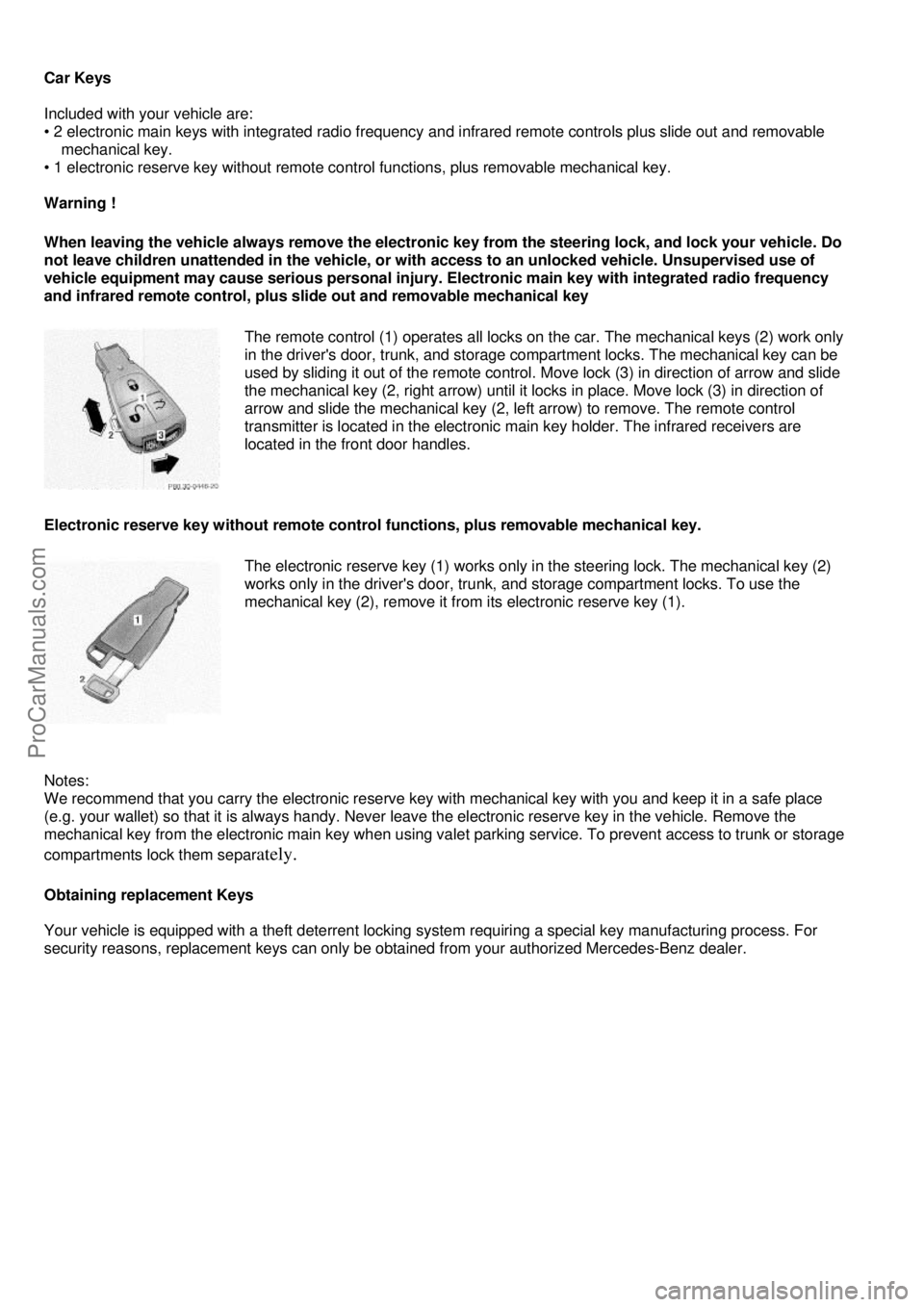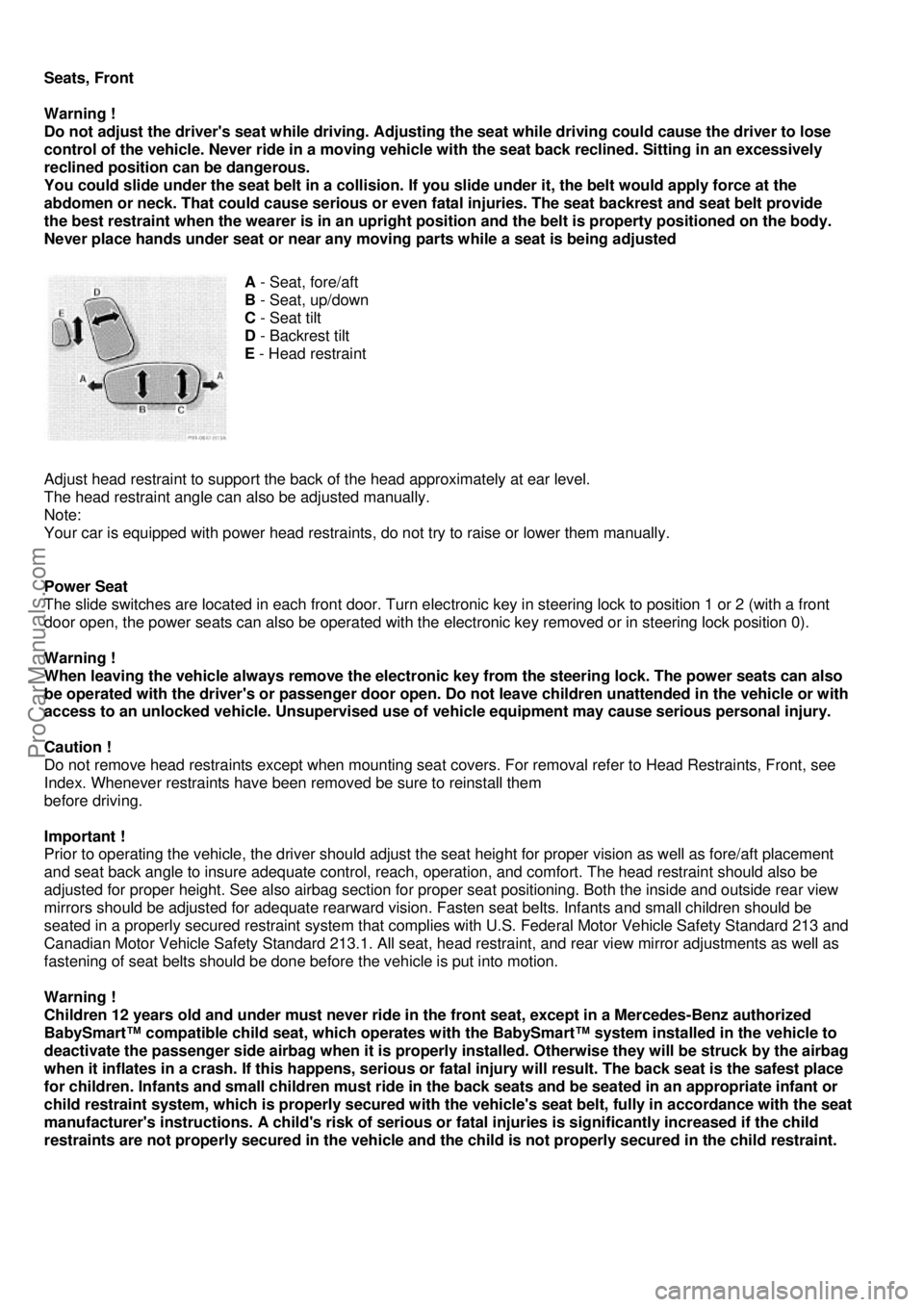1999 MERCEDES-BENZ C-280 warning
[x] Cancel search: warningPage 15 of 122

Car Keys
Included with your vehicle are:
• 2 electronic main keys with integrated radio frequency and infrared remote controls plus slide out and removable
mechanical key.
• 1 electronic reserve key without remote control functions, plus removable mechanical key.
Warning !
When leaving the vehicle always remove the electronic key from the steering lock, and lock your vehicle. Do
not leave children unattended in the vehicle, or with access to an unlocked vehicle. Unsupervised use of
vehicle equipment may cause serious personal injury. Electronic main key with integrated radio frequency
and infrared remote control, plus slide out and removable mechanical key
The remote control (1) operates all locks on the car. The mechanical keys (2) work only
in the driver's door, trunk, and storage comp artment locks. The mechanical key can be
used by sliding it out of the remote control. Move lock (3) in direction of arrow and slide
the mechanical key (2, right arrow) until it locks in place. Move lock (3) in direction of
arrow and slide the mechanical key (2, left arrow) to remove. The remote control
transmitter is located in the electronic ma in key holder. The infrared receivers are
located in the front door handles.
Electronic reserve key without remote control functions, plus removable mechanical key.
The electronic reserve key (1) works only in the steering lock. The mechanical key (2)
works only in the driver's door, trunk, an d storage compartment locks. To use the
mechanical key (2), remove it from its electronic reserve key (1).
Notes:
We recommend that you carry the electronic reserve key wi th mechanical key with you and keep it in a safe place
(e.g. your wallet) so that it is always handy. Never le ave the electronic reserve key in the vehicle. Remove the
mechanical key from the electronic main key when using va let parking service. To prevent access to trunk or storage
compartments lock them separ
ately.
Obtaining replacement Keys
Your vehicle is equipped with a theft deterrent locking system requiring a special key manufacturing process. For
security reasons, replacement keys can only be obtained from your authorized Mercedes-Benz dealer.
ProCarManuals.com
Page 19 of 122

Opening the Trunk
A minimum height clearance of 5.9 ft ( 1.8 m) is required to open the trunk lid. Press transmit button
until trunk lid is open.
Important !
Do not place remote control in trunk since trunk is locked again when closing the lid.
Note:
If the trunk was previously locked separately, it will remain locked (see Index).
Opening and Closing Windows and Sliding/Pop-Up Roof from Outside
Aim transmitter eye (5) of remote control at door receivers (6 or 7).
To open:
Continue to press transmit button
after unlocking car
The windows and sliding/pop-up roof begin to open after approx. 1 second. To interrupt opening
procedure, release button.
To close:
Continue to press transmit button
after locking car
The windows and sliding/pop-up roof begin to cl ose after approx. 1 second. To interrupt closing
procedure, release button.
Warning !
Never operate the windows or sliding/pop-up roof if there is the possibility of anyone being
harmed by the opening or closing procedure.
In case the procedure causes potential danger, the procedure can be immediately halted by
releasing the remote control button. To reverse direction of movement press
for opening
or
for closing.
Note:
If the windows and sliding/ pop-up r oof cannot be operated automatically by pressing the transmit
button of the remote control then it may be necessa ry to change the batteries in the transmitter
(if ok, battery check lamp in transmitter will light briefly when transmitting), or to synchronize the
electronic main key, see Electronic main key, in Index.
ProCarManuals.com
Page 24 of 122

Power Windows and Sliding/Pop-Up Roof
1 - Opening
2 - Interrupting
3 - Closing
When locking doors or trunk, turn mechanical key in door lock or trunk lock to position 3 and hold.
The windows and the sliding/pop-up roof begin to cl ose automatically after approximately 1 second.
To interrupt the closing procedure, turn mechanical key to position 2. When unlocking doors or trunk,
turn mechanical key in door lock or trunk lock to position 1 and hold. The windows and the
sliding/pop-up roof begin to open automatically after approximately 1 second. To interrupt the opening
procedure, turn mechanical key to position 2.
Warning !
Never operate the windows or sliding/pop-up roof if there is the possibility of anyone being
harmed by the procedure. In case the procedure causes potential danger, the procedure can
be immediately reversed by turning the mechanic al key to the reversed operational direction:
• for opening position (1)
• for closing position (3).
Note:
If the opening/closing procedure is inte rrupted, it can only be continued by first turning the mechanical
key to the interrupting position (2) and then again to the opening/ closing position (1 or 3) and hold.
ProCarManuals.com
Page 26 of 122

Seats, Front
Warning !
Do not adjust the driver's seat while driving. Adjusting the seat while driving could cause the driver to lose
control of the vehicle. Never ride in a moving vehicle with the seat back reclined. Sitting in an excessively
reclined position can be dangerous.
You could slide under the seat belt in a collision. If you slide under it, the belt would apply force at the
abdomen or neck. That could cause serious or even fatal injuries. The seat backrest and seat belt provide
the best restraint when the wearer is in an upright position and the belt is property positioned on the body.
Never place hands under seat or near any moving parts while a seat is being adjusted
A - Seat, fore/aft
B - Seat, up/down
C - Seat tilt
D - Backrest tilt
E - Head restraint
Adjust head restraint to support the back of the head approximately at ear level.
The head restraint angle can also be adjusted manually.
Note:
Your car is equipped with power head restraints , do not try to raise or lower them manually.
Power Seat
The slide switches are located in each front door. Turn elec tronic key in steering lock to position 1 or 2 (with a front
door open, the power seats can also be operated with the electronic key removed or in steering lock position 0).
Warning !
When leaving the vehicle always remove the electronic key from the steering lock. The power seats can also
be operated with the driver's or passenger door open. Do not leave children unattended in the vehicle or with
access to an unlocked vehicle. Unsupervised use of vehicle equipment may cause serious personal injury.
Caution !
Do not remove head restraints except when mounting seat co vers. For removal refer to Head Restraints, Front, see
Index. Whenever restraints have been removed be sure to reinstall them
before driving.
Important !
Prior to operating the vehicle, the driv er should adjust the seat height for proper vision as well as fore/aft placement
and seat back angle to insure adequate control, reach, operation, and comfort. The head restraint should also be
adjusted for proper height. See also airbag section for prope r seat positioning. Both the inside and outside rear view
mirrors should be adjusted for adequate rearward vision. Fasten seat belts. Infants and small children should be
seated in a properly secured restraint system that complies with U.S. Federal Motor Vehicle Safety Standard 213 and
Canadian Motor Vehicle Safety Standard 213.1. All seat, head restraint, and rear view mirror adjustments as well as
fastening of seat belts should be done before the vehicle is put into motion.
Warning !
Children 12 years old and under must never ride in the front seat, except in a Mercedes-Benz authorized
BabySmart™ compatible child seat, which operates with the BabySmart™ system installed in the vehicle to
deactivate the passenger side airbag when it is properly installed. Otherwise they will be struck by the airbag
when it inflates in a crash. If this happens, serious or fatal injury will result. The back seat is the safest place
for children. Infants and small children must ride in the back seats and be seated in an appropriate infant or
child restraint system, which is properly secured with the vehicle's seat belt, fully in accordance with the seat
manufacturer's instructions. A child's risk of serious or fatal injuries is significantly increased if the child
restraints are not properly secured in the vehicle and the child is not properly secured in the child restraint.
ProCarManuals.com
Page 30 of 122

Armrest (Rear Bench Seat)
Pull down the armrest. For removal of rear seat cushion, see Index.
Cup Holder in Rear Bench Armrest
Briefly press drawer and pull out to its detent.
Caution!
Keep cup holder closed while travelling. Place only containers
that fit into the cup holder to prevent spills.
Do not fill containers to a height where the contents could spill
during vehicle maneuvers, especially hot liquids.
Adjusting Telescoping Steering Column (optional)
Warning!
Do not adjust the steering wheel while driving. The telescoping
adjustment must be locked while driving. Adjusting the steering
wheel while driving, or driving without the telescoping adjustment
locked could cause the driver to lose control of the vehicle.
Unlocking:
Pull handle (1) out to its stop. The indicator lamp comes on.
Adjusting:
To lengthen or shorten the steering column, pull out or push in steering wheel.
Locking:
Push handle (1) in until it engages.
The indicator lamp goes out.
Important!
With the electronic key in steering lock position 2, an indicator lamp in the instrument cluster comes on. It should go
out when the engine is running. If the indicator lamp does not go out after starting the engine, the adjustable steering
column is not locked properly. Do not drive the vehi cle until you have properly locked the steering column.
ProCarManuals.com
Page 32 of 122

Seat Belts
Your vehicle is equipped with seat belts for all seats, emergency tensioning retractors for the front
seats, as well as front and side impact airbags and knee bolsters for driver and front passenger.
Important !
Laws in most states and all Canadian provinces require seat belt use. All states and provinces
require use of child restraints that comply with U.S. Federal Motor Vehicle Safety Standard 213 and
Canadian Motor Vehicle Safety Standard 213.1.
For your safety and that of your pass engers we strongly recommend their use.
Warning !
Children 12 years old and under must never ride in the front seat, except in a Mercedes-Benz
authorized BabySmart? compatible child seat, which operates with the BabySmart? system
installed in the vehicle to deactivate the passenger side front airbag when it is properly
installed. Otherwise they will be struck by the airbag when it inflates in a crash. If this
happens, serious or fatal injury will result. The back seat is the safest place for children.
Infants and small children must ride in back seats and be seated in an appropriate infant or
child restraint system, which is properly secured with the vehicle's seat belt, fully in
accordance with the seat manufacturer's instructions. A child's risk of serious or fatal
injuries is significantly increased if the child restraints are not properly secured in the vehicle
and the child is not properly secured in the child restraint.
Warning !
Never ride in a moving vehicle with the seat back reclined. Sitting in an excessively reclined
position can be dangerous. You could slide under the seat belt in a collision. If you slide
under it, the belt would apply force at the abdomen or neck. That could cause serious or even
fatal injuries. The seat back and seat belts provide the best restraint when the wearer is in an
upright position and belts are properly positioned on the body.
Seat Belt Warning System
With the electronic key in steering lock position 2, a warning sounds for a short time if the driver's
seat belt is not fastened.
Warning !
Failure to wear and properly fasten and position your seat belt greatly increases your risk of
injuries and their likely severity in an accident. You and your passengers should always wear
seat belts.
If you are ever in an accident, your injuries can be considerably more severe without your
seat belt properly buckled. Without your seat belt buckled, you are much more likely
to hit the interior of the vehicle or be ejected from it. You can be seriously injured or killed.
In the same crash, the possibility for injury or death is lessened with your seat belt
buckled.
ProCarManuals.com
Page 34 of 122

Warning !
USE SEAT BELTS PROPERLY.
• Each occu
pant should wear their seat belt at a ll times, because seat belts help reduce the likelihood of
and potential severity of injuries in accidents, including rollovers. "SRS" (driver airbag, front passenger
airbag, front door side impact airbags), "ETR" (seat belt emergency tensioning retractors), and knee
bolsters are impacts which exceed preset deployment thresholds.
• Improperly positioned seat belts do not provide maximum protection and may
cause serious injuries in case of an accident.
• Never wear the shoulder belt under your arm, against your neck or off your shoulder. In a crash, your body
would move too far forward. That would increase the chance of head and neck injuries. The belt would
also apply too much force to the ribs or abdomen, which could severely injure infernal organs such as
your liver or spleen.
• Position the lap belt as low as possible on your hips and not across the abdomen.
If the belt is positioned across your abdomen, it could cause serious injuries in a crash.
• Each seat belt should never be used for more than one person at a time.
Do not fasten a seat belt around a person and objects.
• Belts should not be worn twisted. In a crash, you wouldn't have the full width of the belt to
manage impact forces. The twisted belt against your body could cause injuries.
• Pregnant women should also use a lap-shoulder belt. The lap belt portion should be positioned
as low as possible on the hips to avoid any possible pressure on the abdomen.
Warning !
USE CHILD RESTRA INTS PROPERLY.
Children 12 years old and under must never ride in the front seat, except in a Mercedes-Benz authorized
Baby Smart™ compatible child seat, which operates with the BabySmart™ system installed in the vehicle to
deactivate the passenger side front airbag when it is properly installed. Otherwise they will be struck by the
airbag when it inflates in a crash. If this happens, serious or fatal injury will result. The back seat is the safest
place for children. Infants and small children must ride in back seats and be seated in an appropriate infant
or child restraint system, which is properly secured with the vehicle's seat belt, fully in accordance with the
seat manufacturer's instructions.
A child's risk of serious or fatal injuries is significant ly increased if the child restraints are not properly
secured in the vehicle and the child is not properly secured in the child restraint. Children too big for child
restraint systems must ride in back seats using regular seat belts. Position shoulder belt across chest and
shoulder, not face or neck. A booster seat may be necessary to achieve proper belt positioning.
ProCarManuals.com
Page 35 of 122

BabySmart™ Airbag Deactivation System
Special child seats, designed for use with the Mercedes-Benz system and available at any
authorized Mercedes-Benz dealer are required for use with the BabySmart™ airbag deactivation
system. With the special child seat properly insta lled, the passenger front airbag will not deploy. The
indicator lamp located on the center console will be illuminated, except with electronic key
removed or in steering lock position 0. The system does not deactivate the door mounted side
impact airbag.
Warning !
The BabySmart™ Airbag Deactivation System will ONLY work with a special seat designed to
operate with it. It will not work with seats which are not BabySmart™ compatible. Never place
anything between seat cushion and child seat (e .g. pillow), since it reduces the effectiveness
of the deactivation system. Follow the manufacture r's instructions for installation of special
child seats. The passenger side front airbag will not deploy only if the
indicator lamp
remains illuminated. Please be sure to check the indicator every time you use the special
system child seat. Should the light go out while the restraint is installed, please check
installation. If the light remains out, do not use the BabySmart™ restraint to transport
children, or otherwise do not transport child restraints on the front passenger seat until the
system has been repaired.
Self-Test BabySmart™ Without Special Child Seat Installed
After turning electronic key in steering lock to position 1 or 2, the
indicator lamp located on
center console comes on for approx. 6 seconds.
If the lamp should not come on or is continuously li t, the system is not functioning. You must see an
authorized Mercedes-Benz dealer before using any child seat.
BabySmart is a trademark of Siemens Automotive Corp.
ProCarManuals.com